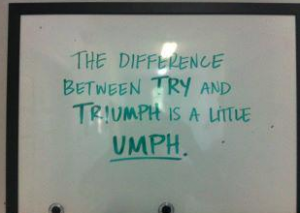My pal and fitness expert, Mike Inscho (creator of AlphaMaleFTS.com) sent me this challenge.
This is something totally different for me. Although he describes himself doing the challenge in the snow, I don’t think I’m up for it in -21C and snow here in Calgary, Canada today.
So, I’ll give this a go in my soccer center and report back.
Check out Mike’s video and post below, and then DO IT and let us know what you think….Thanks again Mike (I think), my lunch may have a repeat performance when I’m done…Take it away Mike:
It was snowing out. Big, fat snow flakes falling from the clouds and adding to the 10 inches of snow that already covered the ground.
I was outside. In just gym shorts. Hands on my knees, sweat running off of my chin, trying like hell to catch my breath, legs barely strong enough to keep me from laying down in the snow.
Damn the 300 yard shuttle run. Damn it straight to hell.
It was part of our spring training program for college football and it was blatantly obvious that our strength and conditioning coach was in love with the 300 yard shuttle. It was the ultimate challenge workout for your body and for your mental strength. Every Wednesday was shuttle day and every Wednesday we knew the drill.
Warm up, go lift, head to the field house when everyone was finished and then pair up. The first guy ran his shuttle while the second waited and hoped it wouldn’t be as bad this week. When the first guy finished the second guy took off, leaving the first with his hands over his heads trying to catch his breath. He knew he’d be running again in less than a minute.
Repeat that 6 times. Every time you finished another one your hands moved farther down your body because you physically were too tired to lift them. First they were on your head, then it was your hips, then it was your knees and then – if you pushed yourself too far – they were holding the edge of the trash can just in case breakfast decided to make an encore appearance.
The 300 yard shuttle is only 25 yards run 12 times. That’s it. Surely you can eek out a decent performance since you’re only running a short distance.
Au contraire my friend. There is much more too it than running a short 25 yards. You have the acceleration part of the run, the deceleration part, reaching top speed for just a few strides before you have to taper down to make the cut and change direction. That last part, the change of direction, is the worst. It will haunt you as you get closer to the end. You will plant your foot to pivot and drive off back in the direction you came and you will swear you stepped in a bear trap and are stuck.
How do you tackle this beast? With humility and knowing that, truly, what doesn’t kill you will make you stronger. Let’s hope this didn’t scare you off too much because if so you are missing out on one of the greatest methods of high intensity interval training there is.
It’s the greatest because it’s scalable for any level of fitness. Because it can be done anywhere you have a few yards of flat ground. Because it takes you to that place where quitting sounds like a good idea but at the same time you know you can finish it. Lastly, because it makes you compete against yourself.
All you need to do is mark out 25 yards. On a football field it’s easy, goal line to 25-yard line. On a soccer field you can go from end line to the end of the goalie box. On a basketball court you can go from baseline to the opposite foul line. If you just have patch of flat land, drop something to mark the start point, take 25 large steps and then drop something to mark the end.
Next, either on your own or with a partner, start your stop watch as you run from start point to end. When you get near the end you’ll need to slow down, drop your hips to decelerate yourself, plant your foot and pivot 180 degrees so you can run back to the start point. Once you get close to the start point you will decelerate, plant, pivot and head back towards the other end.
Once you’ve run the 25 yard distance 12 times total (6 times down and back) you’ve hit the magically 300 yard mark, you can take break and check how long it took you to complete it. Now you’ll rest and then run it all again. The entire goal with this type of challenge is to hit a certain time the first rep and then do it under your first time plus 2 seconds for the second. Example, Ms. Shawnasty (the bestest trainer in all the Great White North) runs her first 300 yard shuttle in 70 seconds. For Ms. Shawnasty’s second 300 yard shuttle she should aim to beat or match the 70 seconds, but is allowed to finish in 72 seconds.
Why is the 300 yard shuttle run the most challenging workout there is?
Energy systems my friend, energy systems. Our body uses different methods of shuttling and creating energy dependent on what type of activity we’re doing. I’ll spare you the in depth analysis and just tell you that the 300 yard shuttle uses the anaerobic lactic system. This energy system only has enough energy in ready supply for 100m-300m worth of movement at a 75%-85% pace. If you’re not running, this means you only have enough energy to do 15-60 seconds of work.
By the time you get to 200yds you’re nearing the end of the amount of energy you have stored in the anaerobic lactic system. You’re pushing and digging deep to finish and you’re body is grabbing every last bit of energy it can. After you do 300 yard shuttles for 4 or more weeks you’ll be able to get farther before you starts feeling your body digging deep for this energy.
Guess what you do then? You run faster.
Like I said earlier, this exercise is scalable to any fitness level and is something you will literally ALWAYS be able to do no matter how fast you can run, far you can run or what type of running surface you have. Go try it out and give yourself a nice challenge.
Mike Inscho is the creator of AlphaMaleFTS.com. His focus is on no frills, stick to the basics training. This all comes from his experiences playing for a nationally ranked NCAA football program, his time in the military and competing in amateur track and field competitions.







